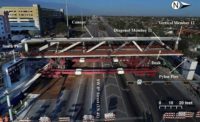 AP/Wideworld Column form collapse June 14 killed one worker on south side of U.S. Highway 90 bridge, under construction near Bay St. Louis, Miss. Rescuers continued to search for a second victim. Seven workers were recovered and treated at a nearby hospitals.
|
Just before 3 p.m. CST on June 15, rescuers recovered the body of a worker missing for 25 hours after a form collapsed during a concrete pour on a project to replace the U.S. Hwy. 90 bridge over Mississippi’s Bay of St. Louis.
Gary Hargrove, Harrison County coroner, identified the victim as Delfino Beltran, 40, of Austin, Texas. Cause of death was drowning. Beltran was the last of nine people to be accounted for after they were thrown into the bay June 14. The other eight were pulled from the water by co-workers and transported by rescue personnel to area hospitals, where one, Alger Pennaman, 51 of Jackson, Miss. was pronounced dead. An autopsy showed Pennaman also died of drowning, according to Hargrove.
“OSHA has an open investigation,” says Dan Fuqua, public affairs director for the Atlanta region of the Office of Safety and Health Administration. “They have six months to complete it.”
|
The project celebrated a major milestone on May 17 when the Mississippi Dept. of Transportation held a grand opening of the first span of the twin-span bridge, saluting joint venture contractors Granite Construction Inc., Watsonville, Calif., and Atlanta-based Archer Western Contractors for delivering the first two lanes of traffic on the $266.8-million bridge well ahead of schedule. The JV won a $5-million bonus.
Bill Jackson, Granite’s director of safety, reached at the corporate headquarters in California, says the company shut down operations through the weekend and held an all-hands safety meeting Monday morning. It is “incrementally” going back to work, “but not going back to work on concrete columns until such time as an accurate determination as to cause has been made.”
“It would be premature to speculate yet as to cause,” Jackson says. “We are actively engaged in our own investigation and are cooperating with federal OSHA officials to determine the cause of this accident….I wish I could tell you more, but we are so close to the beginning that unfortunately we don’t know an awful lot.”
The incident is the second fatal accident on the project. According to published reports, Steve Inscore, 47, of Wimberly, Texas, died of injuries suffered on March 20 after the small crewboat he was piloting to support the construction of bridge footings ran into a barge.
Rescue efforts following the roughly 1 p.m. incident June 14 were suspended as darkness fell. Construction debris posed a risk to the safety of the dive team, said Chief Pat Sullivan, with the Gulfport Fire Dept., who was coordinating dive operations. He added that the effort had become “a recovery instead of a rescue because there is nothing that would indicate that he could have survived from what happened….He was on the column. It went over and under water.”
 Angelle Bergeron Ironworker scales rebar on north side Bay St. Louis bridge column form in a photograph from February 2007.
|
A team returned to the site the following morning with four water search dogs. “The cadaver water dogs indicated a particular area,” says Pam San Fillippo, deputy fire chief for the Bay St. Louis Fire Dept. and a volunteer with the Louisiana Search and Rescue Canine team. “They did have to remove some debris to get to him because there was a lot of concrete and rebar, construction materials on him.”
Ladia Baloun, a tugboat operator for a subcontractor, saw the accident happen. “I was sitting there bringing the concrete in,” Baloun says. “The third bucket was in the air with the crane and this thing collapsed.”
Sullivan praised the contractor’s quick and effective response to the emergency. By the time ambulances and emergency rescue personnel arrived workers had already pulled the eight from the water. “The company that is building the bridge did an outstanding job of getting the people they could out of the water, getting the injured workers to dock, triage, medical and assisting us to getting out here immediately after the accident to attempt the rescue,” Sullivan says. “They had already removed the other people with company boats. Workers had jumped into the water to pull other people out.”
Divers worked closely with crane operators at the site, sifting through debris and working a pattern to recover the missing worker. “We rig the debris and everybody moves out of the way of the crane,” Sullivan said the process was “very methodical and makes for a slow operation, but we feel if there is no way to do a rescue, we don’t want to endanger anyone.”
A statement from the Mississippi Dept. of Transportation said traffic was not affected on the recently opened south side of the twin-span bridge. The release also said, “MDOT personnel were not involved in the incident,” and referred all questions to the contractor, GAW. Calls to GAW on site and to Granite were not returned.
Hurricane Katrina destroyed the original bridge over St. Louis Bay August 29, 2005. GAW made history by delivering the first two lanes of the new bridge less than two years later. The contractor received the notice to proceed February 20, 2006, and didn’t actually begin pile driving until May 15, 2006. “No other bridge in the history of the U.S., the size and scope of this magnitude, has ever been done this fast,” said Larry L. “Butch” Brown, MDOT’s executive director.
 Related Links:
Related Links: 


